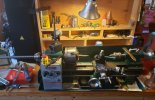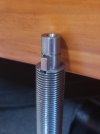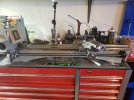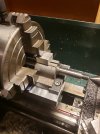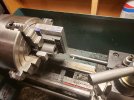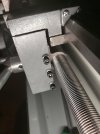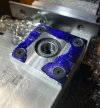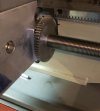Snakeoil
Well-Known Member
As I read these posts, I wonder how many people buy these thinking, "It's a kit, just have to put it together".
My buddy Lance is always finding old machine tools that he gets working again. He's got a horz mill that I think is a Bridgeport. It might be another old New England machinery name. Anyway, he called them about parts and it was so old that they had no record of ever making it.
So, one of his finds is a Chinese lathe that I suspect is about the same size or a big bigger than Ian's "kit". I think it was sold by that tool company that used to sell Bridgeport knock-offs. I'm drawing a blank on their name right now. What triggered my memory was the variable speed controls on the headstock. When Lance got it, the wiring was a mess and he freely admits his limitations with controls systems. Some how he tracked down the maker and managed to get a wiring diagram for the thing. It's got a bunch of relays in the electrical cabinet in the back. I looked at the diagram and it took a while to study it and figure out how the damn thing worked. Part of the problem was what I saw in the diagram did not make sense to me. I could not see how it could work as I suspected it should if it were wired like that diagram. So, I compared what was still terminated on the lathe to the diagram and the lathe agreed with me more than it did with the diagram. I worked my way thru it slowly and then came the moment of truth. On with the power, no arcs or smoke and hitting the on and jog buttons did what they were supposed to and it ran nicely. If I remember right, this one had a bad lead screw. He found one on line somewhere, directly from China for small money. Might saddle up the Harley and take a ride over to his shop today and if I do, I'll snap some photos of the lathe. Might be the granpa or at least older brother to Ian's.
UPDATE: ENCO is the outfit that sold the Bridgeport knockoffs.
My buddy Lance is always finding old machine tools that he gets working again. He's got a horz mill that I think is a Bridgeport. It might be another old New England machinery name. Anyway, he called them about parts and it was so old that they had no record of ever making it.
So, one of his finds is a Chinese lathe that I suspect is about the same size or a big bigger than Ian's "kit". I think it was sold by that tool company that used to sell Bridgeport knock-offs. I'm drawing a blank on their name right now. What triggered my memory was the variable speed controls on the headstock. When Lance got it, the wiring was a mess and he freely admits his limitations with controls systems. Some how he tracked down the maker and managed to get a wiring diagram for the thing. It's got a bunch of relays in the electrical cabinet in the back. I looked at the diagram and it took a while to study it and figure out how the damn thing worked. Part of the problem was what I saw in the diagram did not make sense to me. I could not see how it could work as I suspected it should if it were wired like that diagram. So, I compared what was still terminated on the lathe to the diagram and the lathe agreed with me more than it did with the diagram. I worked my way thru it slowly and then came the moment of truth. On with the power, no arcs or smoke and hitting the on and jog buttons did what they were supposed to and it ran nicely. If I remember right, this one had a bad lead screw. He found one on line somewhere, directly from China for small money. Might saddle up the Harley and take a ride over to his shop today and if I do, I'll snap some photos of the lathe. Might be the granpa or at least older brother to Ian's.
UPDATE: ENCO is the outfit that sold the Bridgeport knockoffs.
Last edited:

